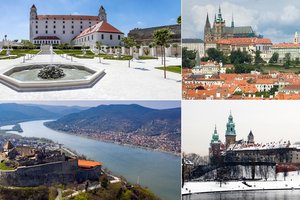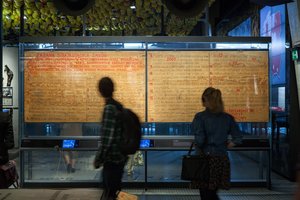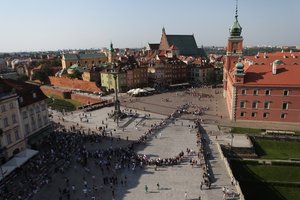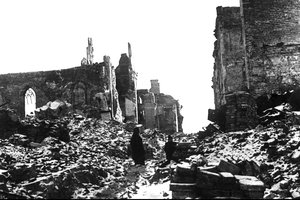The heroes of the two flags
In a walled-in area of 300 ha, the Germans in 1940 herded together some 400,000 residents of Warsaw and its environs and the displaced people from lands incorporated into the Reich. The appalling conditions inside the ghetto, disease and starvation killed dozens of thousands of them. On 22 July 1942, the German authorities began to empty the Warsaw Ghetto of its inhabitants. Those who stayed, decided to put up resistance in spring 1943. On 19 April 1943, an uprising broke out in the Warsaw ghetto — the largest Jewish armed struggle in the Second World War and the first act of resistance against the invader in occupied Europe. In spite of the disproportion of forces, the fighting would continue for almost a month.
 The ghetto liquidation was an element of the Nazi plan to exterminate European Jewry, which was presented in 1942 January at the Wannesee conference. Each day, the Council of Elders which managed the ghetto had to provide 6,000 people for transports. Official announcements read that the transports were to relocate people. In reality, the trains setting off from the Umschlagplatz went to the extermination camp in Treblinka. Approx. 300,000 people were transported there, most of them to their deaths. Some 10,000 died along the deportation, while 11,000 were sent to forced labour camps in Majdanek and Trawniki.
The ghetto liquidation was an element of the Nazi plan to exterminate European Jewry, which was presented in 1942 January at the Wannesee conference. Each day, the Council of Elders which managed the ghetto had to provide 6,000 people for transports. Official announcements read that the transports were to relocate people. In reality, the trains setting off from the Umschlagplatz went to the extermination camp in Treblinka. Approx. 300,000 people were transported there, most of them to their deaths. Some 10,000 died along the deportation, while 11,000 were sent to forced labour camps in Majdanek and Trawniki.
By spring 1943, 60,000 people were left within the ghetto — what saved them was that they worked at German workshops. They were young and most often without families. Having figured out they had nothing to lose, they decided to take up arms.
The final call-up
It did not take long before the first response to the liquidation action emerged, even though political activity was strictly forbidden in the ghetto. The Jewish Fighting Organisation (ŻOB) was established already in July 1942, an underground armed resistance that brought together members of leftist and Zionist youth movements under the command of Mordechaj Anielewicz. In early 1943, the rightist Jewish Military Union (ZŻW) was born, led by Leon Rodal and Paweł Frenkl.
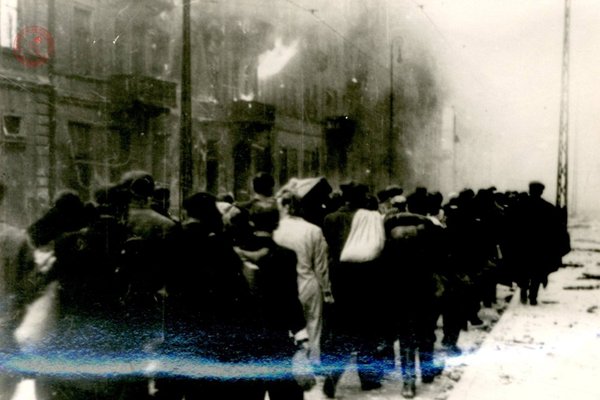 For months, they would call on the civilian population to revolt against successive deportations. In January, they took up arms against German actions. In just a few months, they were able to raise the morale of the people and mobilise them enough to set up bunkers, hidden tunnels and passages. Food and arms were being stored and contacts established with underground Polish organisations.
For months, they would call on the civilian population to revolt against successive deportations. In January, they took up arms against German actions. In just a few months, they were able to raise the morale of the people and mobilise them enough to set up bunkers, hidden tunnels and passages. Food and arms were being stored and contacts established with underground Polish organisations.
Two flags over Warsaw
On 19 April, the eve of Passover, 2,000 German troops equipped with tanks and armoured vehicles surrounded the ghetto. They were confronted by a few hundred ŻOB fighters commanded by Anielewicz and over 150 ŻZW fighters. The Germans had to fall back, which was why SS and Police General Jürgen Stroop took command.
In the first days, the fighting took place in the streets, and the German troops were attacked with stones, petrol bottles, and grenades. A high tenement house at Muranowski Square, the area of intense fighting, displayed two flags: Polish and Jewish. They came to symbolise the Uprising. Also the Polish Resistance tried to provide some support for the fighters by launching a few actions near the ghetto walls.
In the following days, the insurgents were defending single bunkers and buildings. But the German storm troopers searched one quarter after another, burning or detonating homes. They combed through buildings one by one and caught the fighters and civilians. According to historians, 7,000 Jews were shot in the ghetto, while 7,000 deported to Treblinka and Majdanek and 36,000 to labour camps. Over 100 fighters, including Anielewicz, committed suicide. Just a few dozen saved their lives by escaping from the ghetto through underground sewers. Some of them later took part in the Warsaw Uprising.
Two symbols
The ultimate triumph of the great German army over a few hundred fighters was symbolised by the blowing up of the Great Synagogue at Tłomackie St, on 16 May 1943. That day, Stroop wrote: "The former Jewish residential quarter in Warsaw ceased to exist." What was left of it was razed to the ground by the Germans. They swept ghetto ruins over the following months and intensified Jew hunts beyond the wall, "on the Aryan side."
Doomed to failure, the revolt was the first armed uprising in Nazi-occupied cities of Europe and the largest act of resistance of the Jewish population in the Second World War. It remains a potent symbol of the human struggle for dignity.
Poland.pl
19.04.2019




